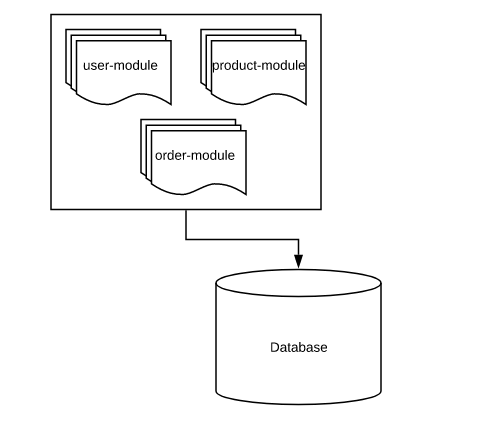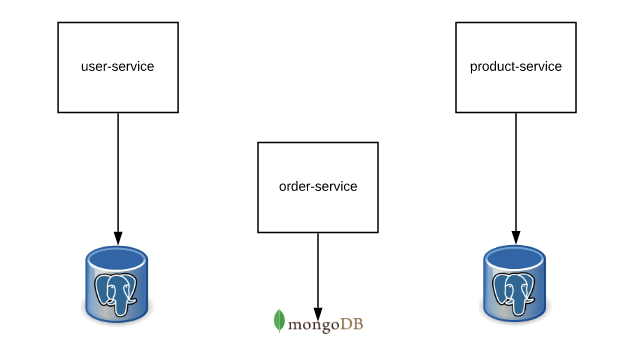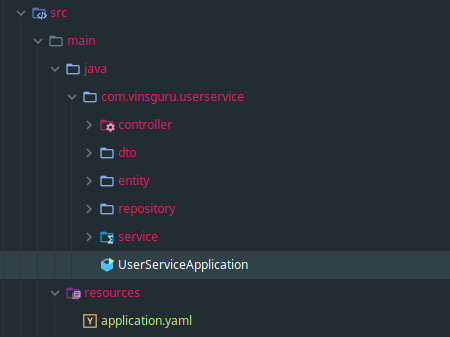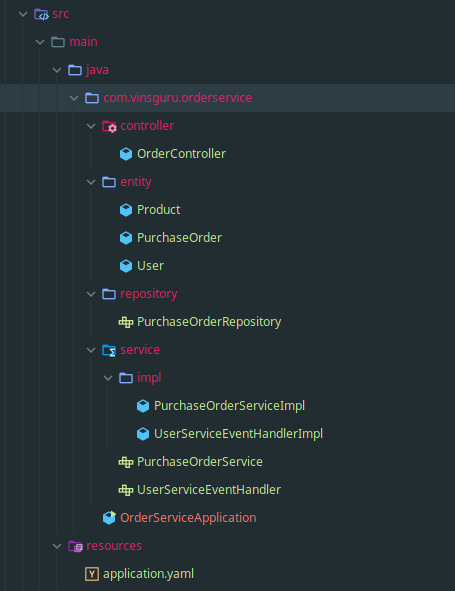Overview:
In this tutorial, I would like to show you one of the Microservice Design Patterns – Event Carried State Transfer to achieve the data consistency among the Microservices.
Event Carried State Transfer:
Modern application technology has changed a lot. In the traditional monolithic architecture which consists of all the modules for an application, we have a database which contains all the tables for all the modules. When we move from the monolith application into Microservice Architecture, we also split our big fat DB into multiple data sources. Each and every service manages its own data.
Having different databases and data models bring advantages into our distributed systems architecture. However when we have multiple data sources, obvious challenge would be how to maintain the data consistency among all the Microservices when one of the modifies the data. The idea behind Event Carried State Transfer pattern is – when a Microservice inserts/modifies/deletes data, it raises an event along with data. So the interested Microservices should consume the event and update their own copy of data accordingly.
Sample Application:
In this example, let’s consider a simple application as shown here. A monolith application has modules like user-module, product-module and order-module.

Our DB for the above application has below tables.
CREATE TABLE users(
id serial PRIMARY KEY,
firstname VARCHAR (50),
lastname VARCHAR (50),
email varchar(50)
);
CREATE TABLE product(
id serial PRIMARY KEY,
description VARCHAR (500),
price numeric (10,2) NOT NULL,
qty_available integer NOT NULL
);
CREATE TABLE purchase_order(
id serial PRIMARY KEY,
user_id integer references users (id),
product_id integer references product (id),
price numeric (10,2) NOT NULL
);When I need to find all the user’s orders, I can write a simple join query like this, fetch the details and show it on the UI.
select
u.firstname,
u.lastname,
p.description,
po.price
from
users u,
product p,
purchase_order po
where
u.id = po.user_id
and p.id = po.product_id
order by u.id;
That was easy! Now let’s assume that we move into Microservice architecture. We have a user-service, product-service and order-service. Each service has it own database.
- user-service
- Microservice responsible for managing user related application functionalities
- user-service connects to a PostgreSQL DB which contains users table

- product-service
- Microservice responsible for managing product related application functionalities
- product-service connects to a PostgreSQL DB which contains product table

- order-service
- Connects to a MongoDB and contains all the user orders along with the product information, price etc.
- MongoDB contains a collection called purchase_order which has information like this.
[
{
"userId":1,
"productId":1,
"price":300.00
},
{
"userId":2,
"productId":1,
"price":250.00
},
{
"userId":2,
"productId":2,
"price":650.00
},
{
"userId":3,
"productId":3,
"price":320.00
}
]Now in the above case, when we look for all the user’s order, we can not simply write a join query across all the different data sources as we did earlier. We need to first send a request to order-service. Once we get the response from the order-service, based on the userId and productId it has, We also need to send a request to user-service and product-service to get the user and product details, process the data and show it on the UI. It looks like a lot of work, HTTP calls, network latency to deal with and they are all going to affect performance of the application very badly.
It also creates tight coupling among microservices which is bad! What will happen when the user-service is not available? It will also make the order-service FAIL which we do not want!!!
One possible solution which might sound very bad advice to you is having the user and product information in the purchase_order collection itself in the MongoDB as shown here.
{
"user":{
"id":1,
"firstname":"vins",
"lastname":"guru",
"email: "admin@vinsguru.com"
},
"product":{
"id":1,
"description":"ipad"
},
"price":300.00
}In this approach, order-service itself has all the information for us to show the data on the UI. It does not depend on other services like user-service, product-service to provide the information we need. It is loosely coupled.
Advantages:
- No more table join.
- Less network calls
- Improved performance
- Loose coupling
Why it might sound very bad is because, data is redundantly stored and what if user changes his name / email? or what if the product description is updated? In the traditional approach, It was not a problem. Now order-service would not have the updated information. It would have stale data if user or product info is updated.
Disadvantages:
- Stale data (user-service updates an user info, order-service will have stale data)
- Redundant data (means additional disk space)
Redundant data/Additional disk space is really not a problem nowadays as data storage is very very cheap! But We can update the user details in the order-service whenever user-details are updated in the user-service. It would be happening asynchronously. Eventual consistency is the trade off for the performance / resilient design we get!
Lets see how we can maintain updated data across all the microservices using Kafka to avoid the above mentioned problem!
Kafka Infrastructure Setup:
We need to have Kafka cluster up and running along with ZooKeeper. Take a look at these articles first If you have not already!
- Kafka – Local Infrastructure Setup Using Docker Compose
- Kafka – Creating Simple Producer & Consumer Applications Using Spring Boot
As part of this article, We are going to update order-service’s user details whenever there is an update on user details in the user-service asynchronously. For that we are going to create a topic called user-service-event in our Kafka cluster.
User Service:
- I am creating a simple spring boot application for user-service with below dependencies.
<dependency>
<groupId>org.springframework.boot</groupId>
<artifactId>spring-boot-starter-data-jpa</artifactId>
</dependency>
<dependency>
<groupId>org.springframework.boot</groupId>
<artifactId>spring-boot-starter-web</artifactId>
</dependency>
<dependency>
<groupId>org.postgresql</groupId>
<artifactId>postgresql</artifactId>
<scope>runtime</scope>
</dependency>
<dependency>
<groupId>org.springframework.kafka</groupId>
<artifactId>spring-kafka</artifactId>
</dependency>- This user-service would be the Kafka-producer. It will add the events to user-service-event topic whenever user details are updated.
- User-service project structure is as shown below.

- User Entity
@Entity
public class Users {
@Id
@GeneratedValue(strategy = GenerationType.IDENTITY)
private Long id;
private String firstname;
private String lastname;
private String email;
// getters and setters
}- User Repository
@Repository
public interface UsersRepository extends JpaRepository<Users, Long> {
}- User DTO
public class UserDto {
private Long id;
private String firstname;
private String lastname;
private String email;
// getters & setters
}- Service
- UserServiceImpl is responsible for updating the user details and adding the details into the Kafka topic
- Updating the database and publishing the event must occur in a single transaction.
public interface UserService {
Long createUser(UserDto userDto);
void updateUser(UserDto userDto);
}
@Service
public class UserServiceImpl implements UserService {
private static final ObjectMapper OBJECT_MAPPER = new ObjectMapper();
@Autowired
private UsersRepository usersRepository;
@Autowired
private KafkaTemplate<Long, String> kafkaTemplate;
@Override
public Long createUser(UserDto userDto) {
Users user = new Users();
user.setFirstname(userDto.getFirstname());
user.setLastname(userDto.getLastname());
user.setEmail(userDto.getEmail());
return this.usersRepository.save(user).getId();
}
@Override
@Transactional
public void updateUser(UserDto userDto) {
this.usersRepository.findById(userDto.getId())
.ifPresent(user -> {
user.setFirstname(userDto.getFirstname());
user.setLastname(userDto.getLastname());
user.setEmail(userDto.getEmail());
this.raiseEvent(userDto);
});
}
private void raiseEvent(UserDto dto){
try{
String value = OBJECT_MAPPER.writeValueAsString(dto);
this.kafkaTemplate.sendDefault(dto.getId(), value);
}catch (Exception e){
e.printStackTrace();
}
}
}- User Controller
@RestController
@RequestMapping("/user-service")
public class UserController {
@Autowired
private UserService userService;
@PostMapping("/create")
public Long createUser(@RequestBody UserDto userDto){
return this.userService.createUser(userDto);
}
@PutMapping("/update")
public void updateUser(@RequestBody UserDto userDto){
this.userService.updateUser(userDto);
}
}- Application.yaml and Kafka configuration
spring:
datasource:
url: jdbc:postgresql://localhost:5432/userdb
username: vinsguru
password: admin
kafka:
bootstrap-servers:
- localhost:9091
- localhost:9092
- localhost:9093
template:
default-topic: user-service-event
producer:
key-serializer: org.apache.kafka.common.serialization.LongSerializer
value-serializer: org.apache.kafka.common.serialization.StringSerializer- At this point, we should be able to successfully run the user-service. We should be able to create users / update users. Whenever user info is updated, we raise an event to the Kafka topic. So that interested microservices can subscribe to that.
Order-Service
- I am creating another microservice for order-service with below dependencies. MongoDB would be the backend for this service.
<dependency>
<groupId>org.springframework.boot</groupId>
<artifactId>spring-boot-starter-data-mongodb</artifactId>
</dependency>
<dependency>
<groupId>org.springframework.boot</groupId>
<artifactId>spring-boot-starter-web</artifactId>
</dependency>
<dependency>
<groupId>org.springframework.kafka</groupId>
<artifactId>spring-kafka</artifactId>
</dependency>- This service also needs Kafka dependency as it would be subscribing to the user-service-event topic. This service would be a Kafka consumer.
- Order-service’s project structure would be as shown here.

- Purchase Order Entity
@Document
public class PurchaseOrder {
@Id
private String id;
private User user;
private Product product;
private double price;
// Getters & Setters
}
public class Product {
private long id;
private String description;
// Getters & Setters
}
public class User {
private Long id;
private String firstname;
private String lastname;
private String email;
// Getters & Setters
}- Purchase Order data access layer
@Repository
public interface PurchaseOrderRepository extends MongoRepository<PurchaseOrder, String> {
@Query("{ 'user.id': ?0 }")
List<PurchaseOrder> findByUserId(long userId);
}- Service
- This service class simply retrieves all the data from the DB
- It also make entries when there is a new order
- This service class is not responsible for updating user information
public interface PurchaseOrderService {
List<PurchaseOrder> getPurchaseOrders();
void createPurchaseOrder(PurchaseOrder purchaseOrder);
}
@Service
public class PurchaseOrderServiceImpl implements PurchaseOrderService {
@Autowired
private PurchaseOrderRepository purchaseOrderRepository;
@Override
public List<PurchaseOrder> getPurchaseOrders() {
return this.purchaseOrderRepository.findAll();
}
@Override
public void createPurchaseOrder(PurchaseOrder purchaseOrder) {
this.purchaseOrderRepository.save(purchaseOrder);
}
}- User Service Event Handler
- This service class is responsible for subscribing to a Kafka topic.
- Whenever user-service raises an event, the message would be consumed here immediately and user details would be updated.
public interface UserServiceEventHandler {
void updateUser(User user);
}
@Service
public class UserServiceEventHandlerImpl implements UserServiceEventHandler {
private static final ObjectMapper OBJECT_MAPPER = new ObjectMapper();
@Autowired
private PurchaseOrderRepository purchaseOrderRepository;
@KafkaListener(topics = "user-service-event")
public void consume(String userStr) {
try{
User user = OBJECT_MAPPER.readValue(userStr, User.class);
this.updateUser(user);
}catch(Exception e){
e.printStackTrace();
}
}
@Override
@Transactional
public void updateUser(User user) {
List<PurchaseOrder> userOrders = this.purchaseOrderRepository.findByUserId(user.getId());
userOrders.forEach(p -> p.setUser(user));
this.purchaseOrderRepository.saveAll(userOrders);
}
}- Order Controller
@RestController
@RequestMapping("/order-service")
public class OrderController {
@Autowired
private PurchaseOrderService purchaseOrderService;
@GetMapping("/all")
public List<PurchaseOrder> getAllOrders(){
return this.purchaseOrderService.getPurchaseOrders();
}
@PostMapping("/create")
public void createOrder(@RequestBody PurchaseOrder purchaseOrder){
this.purchaseOrderService.createPurchaseOrder(purchaseOrder);
}
}- Application.yaml and Kafka consumer configuration
spring:
data:
mongodb:
host: localhost
port: 27017
database: order-service
kafka:
bootstrap-servers:
- localhost:9091
- localhost:9092
- localhost:9093
consumer:
group-id: user-service-group
auto-offset-reset: earliest
key-serializer: org.apache.kafka.common.serialization.LongDeserializer
value-serializer: org.apache.kafka.common.serialization.StringDeserializer- At this point, Order-service is also up and running fine. It listens to Kafka topic.
- I created a purchase order and called the GET request to get the below response.
[
{
"id": "5dcfb1056637311008e17f80",
"user": {
"id": 1,
"firstname": "vins",
"lastname": "guru",
"email": "admin@vinsguru.com"
},
"product": {
"id": 1,
"description": "ipad"
},
"price": 300
}
]- Then I send the below PUT request to my user-service.
{
"id": 1,
"firstname":"vins",
"lastname": "gur",
"email": "admin-updated@vinsguru.com"
}- Now I call the purchase order GET request once again. User detail updates are getting reflected immediately in the order-service.
[
{
"id": "5dcfb1056637311008e17f80",
"user": {
"id": 1,
"firstname": "vins",
"lastname": "guru",
"email": "admin-updated@vinsguru.com"
},
"product": {
"id": 1,
"description": "ipad"
},
"price": 300
}
]Source Code:
The source is available here.
Summary:
We were able to maintain data consistency across all the microservices using Kafka. This approach avoids many unnecessary network calls among microservices, improves the performance of microservices and make the microservices loosely coupled. For ex: Order-service does not have to be up and running when user details are updated via user-service. User-service would be raising an event. Order-service can subscribe to that whenever it is up and running. So that information is not going to be lost! In the old approach, it makes microservices tightly coupled in such a way that all the dependent microservices have to be up and running together. Otherwise it would make the system unavailable.


Cool, great post, I hope you keep doing this kind of content, that is very useful.
Dear Vinoth,
Thanks for such a great tutorials. it looks like this particular code example is not complete. The product-service is completely missing and things are not getting clear to me . Could you please update the required stuff?
First I explain the high level concept – just theory. For the demo, I had mentioned that – As part of this article, We are going to update order-service’s user details whenever there is an update on user details in the user-service asynchronously. – So it was intentional.